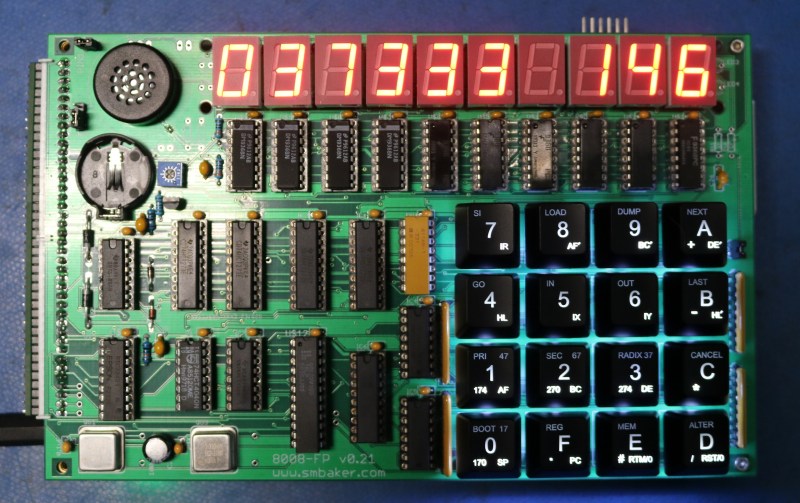The last time we covered [Dr. Scott M. Baker], he made his Heathkit H8 run on a considerably older processor than it was made for. This time, apparently still not satisfied with the number of 8008 computers, he made an Intel 8008-based single-board computer.
The Mini-08, as [Scott] calls it, is based on his previous endeavour of downgrading the Heathkit H8. Its “CPU board” has even more memory than its predecessor at 128KiB RAM and ROM and an 8251 UART connected to a DB25 serial port. The entirely optional “display board” adds to that 10 digits of 7-segment displays, a backlit Cherry MX Blue hexadecimal keypad, a real-time clock and even a 4-voice sound generator!
[Scott] has also done an impressive job with the software, porting BASIC, FORTH, a clone of Star Trek and some utilities to his Mini-08. He demonstrates both BASIC and FORTH by printing “SCOTT WAS HERE” in a for loop and finishes off by showing how to use some of the display board with FORTH.
Like last time, he published design files and resources for you to enjoy. Overall, an interesting spin on the retro single-board computer concept.
Video after the break.
Thanks to [Stephen Walters] for the tip!
















8008 was my first computer wire rapped it from scratch my own design. I learned so much from that computer. It was so slow but worked. Next was the z80. Those the days but never going back.
I’m still wanting an 8088 single board computer with hardware EMS RAM. A couple of PS/2 ports, IDE port for a Disk On Module, VGA video, and a floppy port for a Gotek would be perfect.
Just the thing for old CNC equipment with motion controls that are operated with old DOS software.
I’d go with a NEC V20 at minimum – or better yet, 80186 or V30.
Having a full 16-Bit connection, even if it’s just for IDE and RAM access, is priceless.
The 8088 XT platform never was good, except for establishing DOS PC platform.
One of the original i8086 designer called the i8088 chip “castr*ted”.
Even back in the 1980s computer magazines did report how dreadful slow XTs were for the most basic things.
And I do confirm, I do have a 4,77 XT that’s horrible slow.
I’m with you for hardware EMS, though . EMS uses mapping, which can be more elegant than copying (XMS uses that).
Alas, we merely have that 2MB Lotech EMS board with basic LIM4 support at hand these days. It’s better tjsn nothing, but an Intel Aboveboard or similar would be much nicer.
Btw, there are x86 SBCs these days. They are 486/586 level (Vortex models), but have a PC/104 bus, which is close to ISA.
So it’s somehow possible to install an ISA slot adapter or a custom EMS board with PC/104 conmector.
Anyway, these are just some thoughts.
A classic single board computer with a PCB that has an authentic, 70s era etching style would be cool.
But seriously, please consider not to use an i8088. Consider using an i80188, at least.
That’s a SOC, essentially, so it fits the project nicely. Even a C64’s 6510 is more capable than an i8088..
I used an 80186 (the AMD flavor) for an embedded project in the early 2000s, when that chip was already past its prime. Because it had the same architecture as a PC, it was very easy to develop on. There was an AMD-provided BIOS (which I actually submitted a patch for to improve disk write performance) and it ran DOS from one of those Datalite disk-on-chips. Adding Ethernet was easy because we used a common Ethernet IC and it was pretty simple to tweak the driver for our custom hardware. Adding an ISA bus (for CF cards) was dirt-simple because. It turned out to be a good decision for that project because we could leverage so many skills and existing toolsets.
Back in the esrly 2000’s as the SA for a company thst included a machine shop i periodically scrounged ebay and craigslist for old laptops from 486 and up with DOS, floppies and serial ports to run cnc machines that only had floppy and serial ports on them. They could “drip” data from much larger files than the machines could handle through short shielded serial cables that the newer cad computers and long serial connections could not do reliably in the noisy (emi) environment. Ethernet to serial ‘servers’ were available but far more money than $30 laptop
OK, if you’re going old school, you need to do an an article on the Intel 4004. The first and only 4 bit CPU.
Many of the first programmable calculators ran quite well – slowly – on the 4004. I coded a lot of apps on 4004 and 8008 based machines back then. Considering that the alternative was usually a CDC mini computer, the price was right.